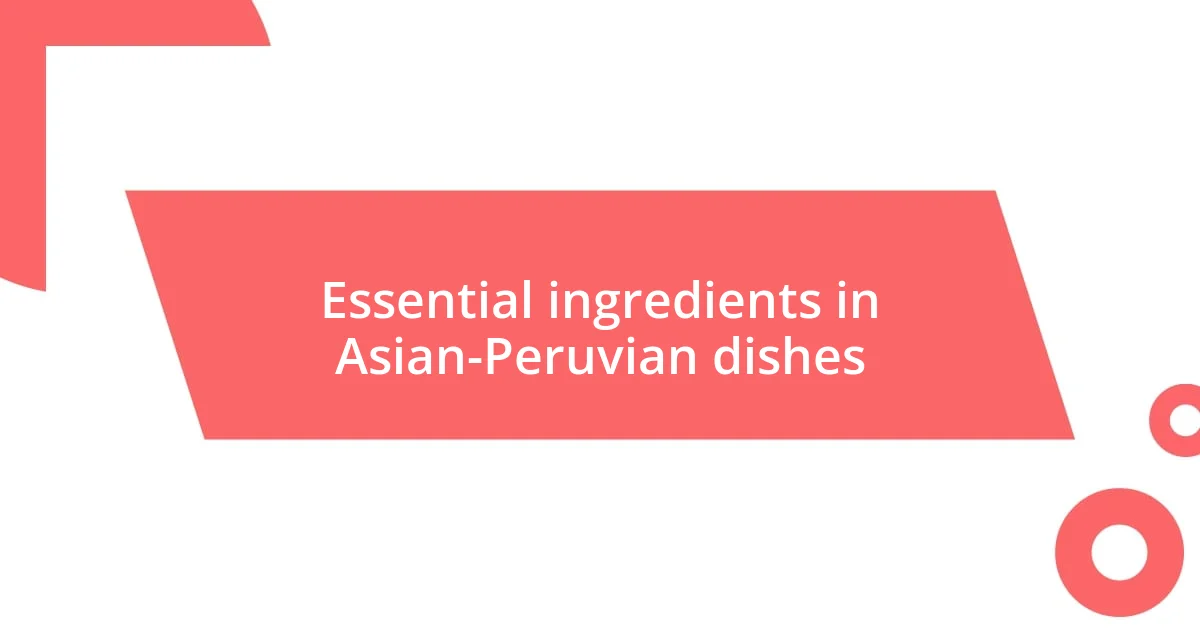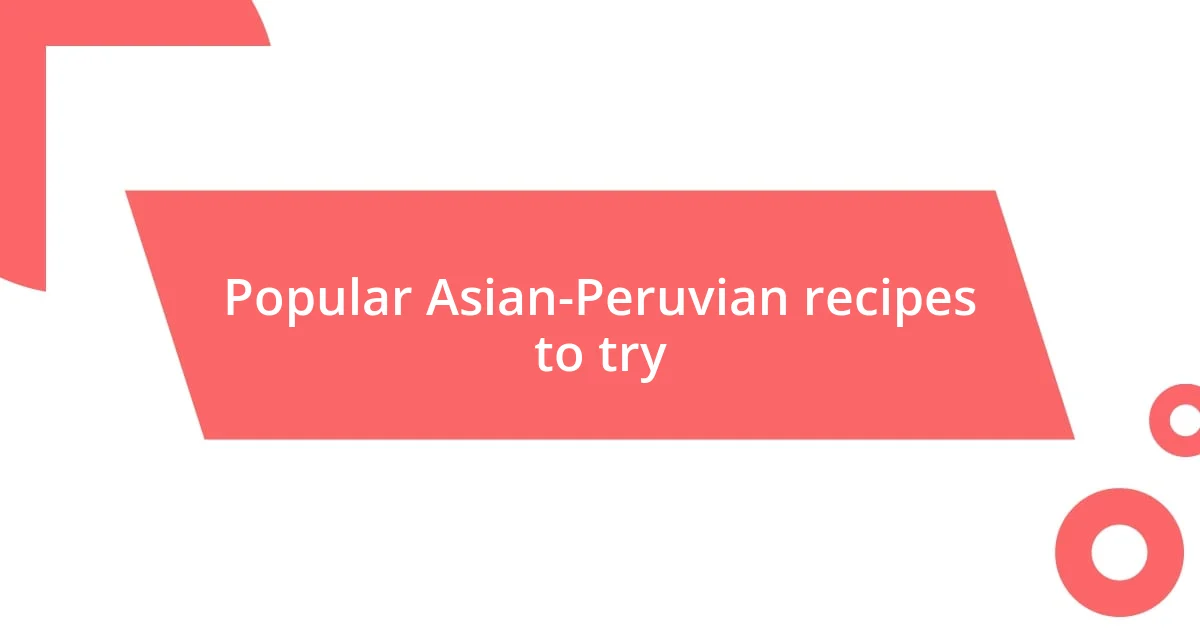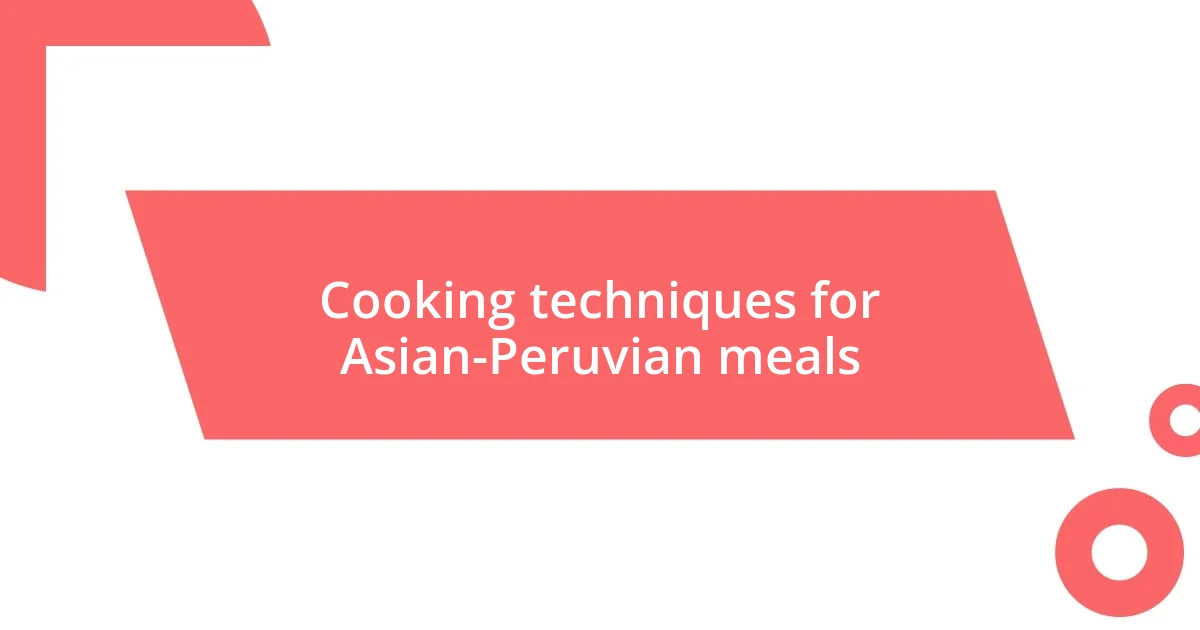Key takeaways:
- Asian-Peruvian dishes showcase a fusion of cultures, combining rich Asian flavors with traditional Peruvian ingredients, creating unique culinary experiences.
- Key ingredients like fresh seafood, aji peppers, and soy sauce highlight the interplay of cultural influences, enhancing the flavor profiles of both cuisines.
- Cooking techniques such as stir-frying and marinating play a significant role in developing flavors, while authentic ingredients can often be found in local Asian and Latin markets.

Introduction to Asian-Peruvian dishes
Asian-Peruvian dishes represent an incredible fusion of cultures, blending rich Asian flavors with traditional Peruvian ingredients. I remember my first encounter with this culinary style at a local restaurant, where the aroma of stir-fried noodles intertwined with the subtle hints of lime and cilantro left me completely mesmerized. Have you ever tasted a dish that made you feel as if you were traveling to different worlds at once?
The beauty of Asian-Peruvian cuisine lies in its ability to surprise the palate and create harmony from seemingly contrasting elements. I had a delightful moment savoring a sushi roll filled with Peruvian ceviche; the freshness of the fish paired with a spicy rocoto sauce was nothing short of sensational. How is it that two distinct cultures can come together to create such joy on a plate?
Exploring these dishes reveals not just a blend of flavors, but a rich narrative of migration and integration. For instance, the use of soy sauce alongside traditional Peruvian ingredients tells a story of history and adaptation, igniting a curiosity in me about the journey of these culinary influences. Can you feel the excitement of discovering something new yet deeply rooted in heritage?

Cultural influences in cuisine
The cultural influences in Asian-Peruvian cuisine reflect a fascinating tapestry woven from the threads of history, migration, and shared experiences. Each bite tells a story, like the time I tried a lomo saltado—a stir-fried beef dish—where the delicate umami of soy sauce melded with the heartiness of Peruvian potatoes. This fusion is not just about combining ingredients; it’s about creating a culinary narrative that resonates with the cultural backgrounds of those who have come together.
- The Chinese immigrants brought ingredients like soy sauce and ginger, enriching Peruvian fare.
- Japanese influences can be seen in dishes like tiradito, where sashimi-style fish highlights the freshness of local seafood.
- The blending of flavors creates an exciting contrast—sweet, sour, salty, and spicy coexist beautifully on the palate.
- Cultural festivals celebrate this fusion, showcasing specific dishes that symbolize unity and collaboration between different communities.
I often find myself thinking about how these cross-cultural exchanges shape the dishes I love. Imagine sitting at a table, surrounded by friends and family, all savoring a delicious plate of Asian-Peruvian fusion. It’s an experience that goes beyond food; it’s about connection and shared heritage, and it keeps me coming back for more.

Essential ingredients in Asian-Peruvian dishes
The essential ingredients in Asian-Peruvian dishes create a unique flavor profile that reflects the diverse cultural influences mingling in this remarkable cuisine. For example, I often find that the use of fresh seafood, such as flounder or scallops, is common in both Peruvian and Japanese traditions. The surprising combination of zesty ceviche alongside delicate sushi brings an exhilarating brightness to the palate. Have you ever tasted the burst of lime paired with the umami of a perfectly prepared fish? It’s an experience that stays with you.
In addition to seafood, staples like ginger and garlic make frequent appearances, enhancing depth and character in dishes. I still recollect the time I tasted a ginger-infused Peruvian chow mein; the vibrant spice took me on a flavor journey that was invigorating. The warmth of ginger, combined with the familiarity of sautéed vegetables and noodles, represented a beautiful bridge between my childhood memories of Asian flavors and my passion for Peruvian cuisine.
Another key ingredient is aji peppers, which bring an exciting heat and flavor to many Asian-Peruvian dishes. When I first tried a dish featuring aji amarillo sauce drizzled over grilled fish, I couldn’t believe how the fiery zest transformed the entire plate. This typical Peruvian ingredient harmonizes perfectly, paying homage to its roots while also celebrating the culinary aspects of Asia.
| Ingredient | Common Usage |
|---|---|
| Fish (e.g., flounder, scallops) | Sushi, ceviche, tiradito |
| Ginger | Soups, stir-fries, marinades |
| Aji Peppers | Sauces, salsas, grilled dishes |

Popular Asian-Peruvian recipes to try
When it comes to popular Asian-Peruvian recipes, one dish that never fails to impress me is Chaufa. This Peruvian stir-fried rice, heavily influenced by Chinese cuisine, often features a delightful mix of leftover meats and vegetables. I remember trying it for the first time at a family gathering, where the aroma of garlic and soy sauce filled the air, evoking memories of my childhood. The layers of flavor made it so comforting; combined with the crispy edges of rice, it was pure bliss on a plate.
Another must-try dish is Tiradito, which is a beautiful representation of the Japanese sashimi style, lovingly infused with Peruvian ingredients. If you’ve never tasted this dish, imagine tender fish, typically covered in a vibrant aji amarillo sauce. It sends delightful tingles through your taste buds! I recall how my friends and I were amazed at how simple yet exquisite it was, like a medley of fresh tastes that celebrate both ocean and earth. Have you ever thought about how something so straightforward can create such profound joy?
And let’s not overlook Lomo Saltado, a classic staple that marries the heartiness of Peruvian cuisine with the vibrancy of Asian flavors. This dish combines marinated strips of beef with onions, tomatoes, and of course, soy sauce. I still cherish the memory of savoring Lomo Saltado at a bustling market stall, where the sizzling aromas drew me in. The blend of flavors was a revelation, reminding me how adaptable and dynamic our culinary landscapes can be. It’s these moments that reinforce my belief that food is a beautiful way to express culture and tell stories.

Cooking techniques for Asian-Peruvian meals
The cooking techniques used in Asian-Peruvian dishes are as fascinating as the ingredients. One method I’ve come to love is stir-frying, a skill I picked up watching my grandmother whip up Chinese-inspired (chǎofàn), or fried rice. The speed at which she transformed simple ingredients into a flavorful dish stuck with me, and I often replicate that same excitement when I prepare Chaufa at home. Have you ever felt the rush of heat from a hot wok? It’s electrifying!
Another technique that stands out is marinating, which I believe adds a layer of depth that we often overlook in cooking. I remember the first time I soaked some beef in a soy-sesame blend before turning it into Lomo Saltado. The meat took on such a deep flavor that I couldn’t help but savor each bite. It’s such a simple step, yet it transforms the dish completely. How can such a small addition create something so memorable?
Then there’s the art of ceviche, a method that has its roots deeply embedded in Peruvian culture but feels almost kin to the Japanese sashimi style. I recall my first encounter with aji-tinged ceviche at a seaside market; the freshness of the fish combined with citrus made it like tasting summer itself. Have you ever encountered a dish that captures a moment in time? That experience made me realize how cooking techniques not only shape flavors but also create lasting memories.

Where to find authentic ingredients
When searching for authentic ingredients for Asian-Peruvian dishes, local Asian markets often reveal a treasure trove. I vividly remember stepping into one near my home, where the vibrant colors and aromatic spices instantly transported me to another culture. From fresh ginger and garlic to a variety of soy sauces, these markets stock everything you need to recreate those beloved recipes at home. Have you ever been overwhelmed by the delicious offerings in an ethnic grocery store?
In my experience, the search for aji amarillo, a key ingredient in many Peruvian dishes, can be a bit trickier. I found it at a specialty Latin grocery store in my city, nestled between jars of olives and bags of quinoa. The moment I held that bright orange chili pepper in my hands, I could already taste the kick it would bring to my Tiradito. It’s exciting to discover these authentic ingredients, isn’t it? They truly bring dishes to life.
Don’t overlook farmers’ markets, either. They often carry fresh produce, including Peruvian staples like cilantro and lime, which are essential for achieving that authentic flavor profile. I still recall discovering a vendor who sold aji that morning; it felt like a small victory. Choosing fresh ingredients not only enhances flavor but also connects me to the vibrant history of these culinary traditions. Isn’t it fascinating how sourcing the right ingredients can transform your cooking experience?

Personal reflections on my journey
My journey into the world of Asian-Peruvian dishes has been like unfolding a beautifully complex story. I remember the first time I tasted Peruvian fried rice at a friend’s house; it was unlike anything I’d had before. The blend of soy sauce and Andean spices made me realize that food could bridge cultures and bring people together in unexpected ways. Have you ever had a dish that made you feel a profound connection to a different culture?
As I delved deeper into these culinary traditions, I found myself embracing the rich tapestry of flavors that define them. I vividly recall my first attempt at making aji de gallina—learning to balance the creamy yellow sauce with just the right amount of spice was a delightful challenge. It was a tangible reflection of my passion for this cuisine. Each stir of the pot felt like a dance of culture, reminding me of how significant food can be in expressing identity and heritage. Isn’t it amazing how cooking can evoke such deep emotions?
Reflecting on my experiences, I genuinely appreciate the way Asian-Peruvian dishes have taught me patience and creativity in the kitchen. The first time I prepared a batch of wontons infused with Peruvian spices, I felt an overwhelming sense of accomplishment. Not only was I crafting a meal, but I was also weaving together two distinct cultures. It’s moments like these that make me realize that food is more than just sustenance; it’s a celebration of life and creativity. How have your cooking experiences shaped your understanding of different cultures?












